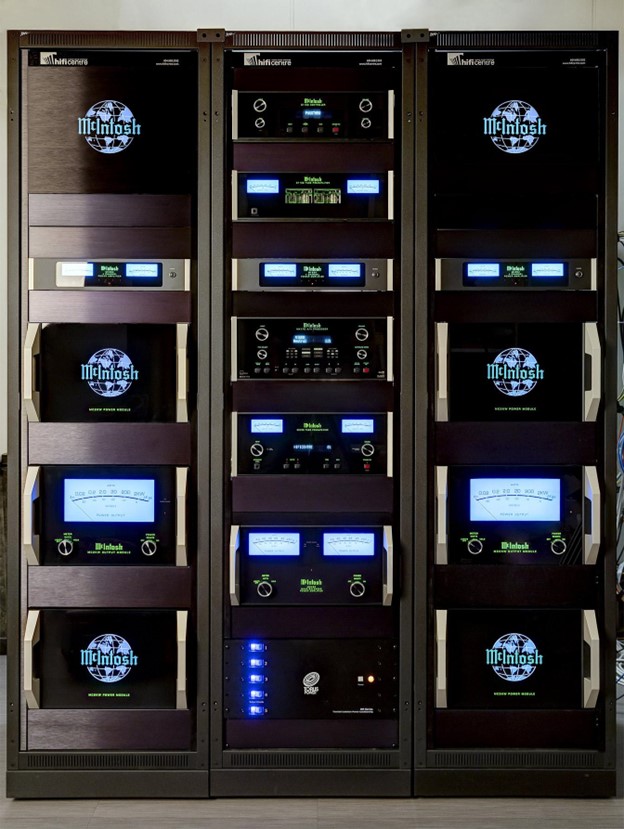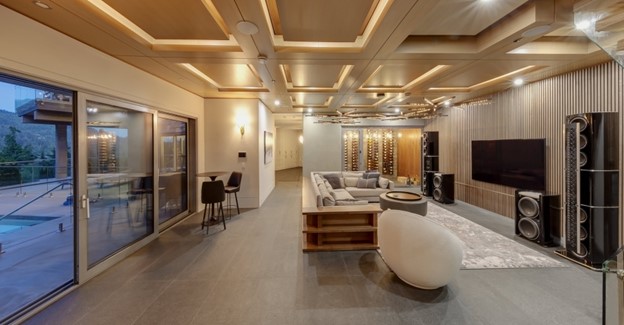Audio/video specialty company Hi-Fi Centre is not your typical AV business. Based in Vancouver, Canada, the company specializes in audio and video systems only. While the company does do some integration, that comes second to the audio/video solutions they provide.
“We don’t consider ourselves an integration company,” said Igor Kivritsky, owner of Hi-Fi Centre. “We made a decision to focus on our specialty, and we are selective in the projects we take on.” When a local homeowner requested a high-end sound system for their media room, the team at Hi-Fi Centre was happy to accept the job.
The homeowners wanted concert-level sound, impact and volume. The media room in the home was a large open space with wooden ceilings and an uncarpeted floor. The space was designed with an open floor plan and included a bar and wine storage area in addition to the gym and home theater located on the same level.
“The homeowners enjoy electronic music,” explained Kivritsky. “They were looking for incredible sound quality at an incredible volume to fill the space.”
The Creation of Sound
To create the sound that the homeowners were seeking, Hi-Fi Centre started with choosing the right speakers. The speakers needed to meet certain criteria to achieve the sound quality, volume and space requirements for the job. In addition to handling uncompressed sound with clarity and volume, the speakers also had to fill the large space without distortion or compression.
Based on the criteria, the team knew traditional hi-fi speakers would not work in the space. Traditional hi-fi speakers have typical configurations with one or two mid-range drivers, a 1-in. tweeter and a couple of woofers. However, these types of speakers lacked the ability to produce the sound pressure levels that the project required. 
The team looked through their trusted brands and turned to McIntosh speakers for the system. The McIntosh XRT2.1K loudspeakers feature 81 drivers comprised of six woofers, two low-frequency midranges, 28 upper-frequency midranges and 45 tweeters, providing the sound experience necessary. One of the benefits of this loudspeaker is the large number of drivers used to lower overall distortion and increase sensitivity, allowing for greater volume while using less power.
There is no speaker on the planet which will have enough low-frequency energy to fill a space that size, “especially when you are listening to electronic music to deliver the punch and impact that is needed,” said Kivrtsky, adding that the array of the loudspeaker also helped control vertical dispersion, necessary due to the ceilings in the space. “Wooden ceilings will cause high frequencies to reflect and become harsh. These loudspeakers have very good dispersion control in the vertical axis and that is exactly what we wanted.”
A pair of subwoofers from JL Audio was next up and featured 13.5-in. drivers with a 3500-watt amplifier, bringing the total system power to 11,000 watts.
“The sound pressure levels in the room easily out beat any nightclub you go to,” said Kivrtsky. “Your ears will start to hurt before you get to the top end of the volume in this system, and it will still be clear undistorted sound.”
McIntosh MC2KW mono amplifiers were installed to drive the system. Each amplifier is comprised of three separate chassis, meaning six boxes were used to make up the left and right amplifiers in the rack. Each amplifier delivers 2000 watts of power, needed to produce zero compression, zero distortion and to ensure that the amps would not run out of power.
Smoothing out the sound is a McIntosh C-1100 tube pre-amplifier along with a McIntosh MX-170 AV processor used in 2-channel mode (plus sub-woofers). Connected to the system is a DJ system with dual decks and a mixer, along with Apple TV, a cable box and gaming consoles. Therefore, the system needed a digital processor that could handle video sources as well as audio. Finally, the wood-paneled wall behind the speakers hid acoustic panels which helped alleviate echo, rounding out the system.
Importance of Power Management
Power management was a large part of the installation. Kivrtsky explained that when dealing with the immense voltages and currents of the system, a strong power solution was vital. Hi-Fi Centre went with their go-to power management manufacturer, Torus Power.
“There is only one power supply company I look at for a system of this size, and it’s Torus Power,” said Kivrtsky. “It wasn’t if we were going to use them — it was which model are we going to use.”
Kivrtsky sent the project specifications to Torus Power engineers, who then recommended the Torus Power solution for the job. Because of the large amount of power needed to keep the system running, the team decided on a Torus Power RM-100 series power supply.
“The power cord that goes into the RM-100 is so thick, you could almost hold up an elevator with it, that’s what our system required,” said Kivrtsky. A dedicated circuit with 50 amps of current at 240 volts was installed by an electrician to provide the necessary power to the RM 100.
The Finishing Touches
It’s all in the details for Hi-Fi Centre as they completed the installation. The team used premium audio, HDMI and power cables throughout the installation to get peak performance of the system.
The placement of the speakers was something that the team spent time on. The distance from the wall and the distance between speakers are crucial to delivering the highest quality of sound with the least amount of electronic intervention. Additionally, the loudspeakers were faced completely forward, a break from the norm of having the speakers face slightly into each other. Calibration of the speakers and subwoofers is very important to Hi-Fi Centre and this system was no different. The final calibration was completed with very little adjustment needed.
“Everything was placed correctly, and everything was accounted for, this is a testament to our team and the products we chose,” explained Kivrtsky. “We could have dialed in more electronic changes, but we didn’t need to.”
Integration company Pure Image did the automation on the home and used Control4. “We didn’t have a single control issue; my compliments to them,” Kivrtsky mentioned. The teams at Hi-Fi Centre and Pure Images also worked together on the actual installation of the system.
Once the homeowners were able to use the system, they told Kivrtsky that their system sounded better than the best local nightclub, which was exactly what Hi-Fi Centre set out to do. “I knew it would be good, but I had no idea it would be this good,” the client remarked to Kivrtsky. The incredibly low distortion levels from the audio system allows the clients to maintain conversations while the system plays at high volume without difficulty. An additional benefit is that there is no ringing of the ears when the system is turned off.
Kivrtsky and the team at Hi-Fi Centre relied heavily on the relationships they had with their manufacturers for the project. “There are a lot of great products out there,” said Kivrtsky.
